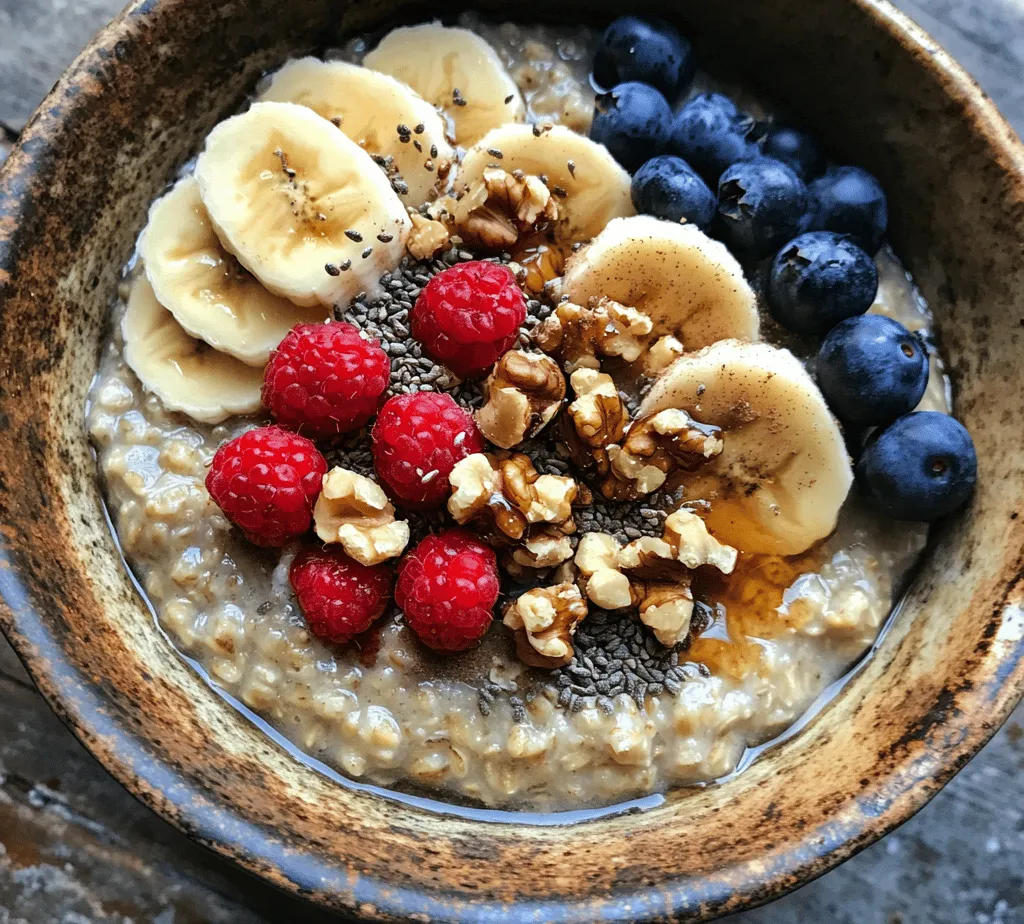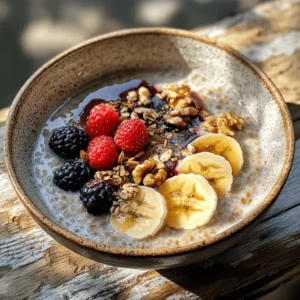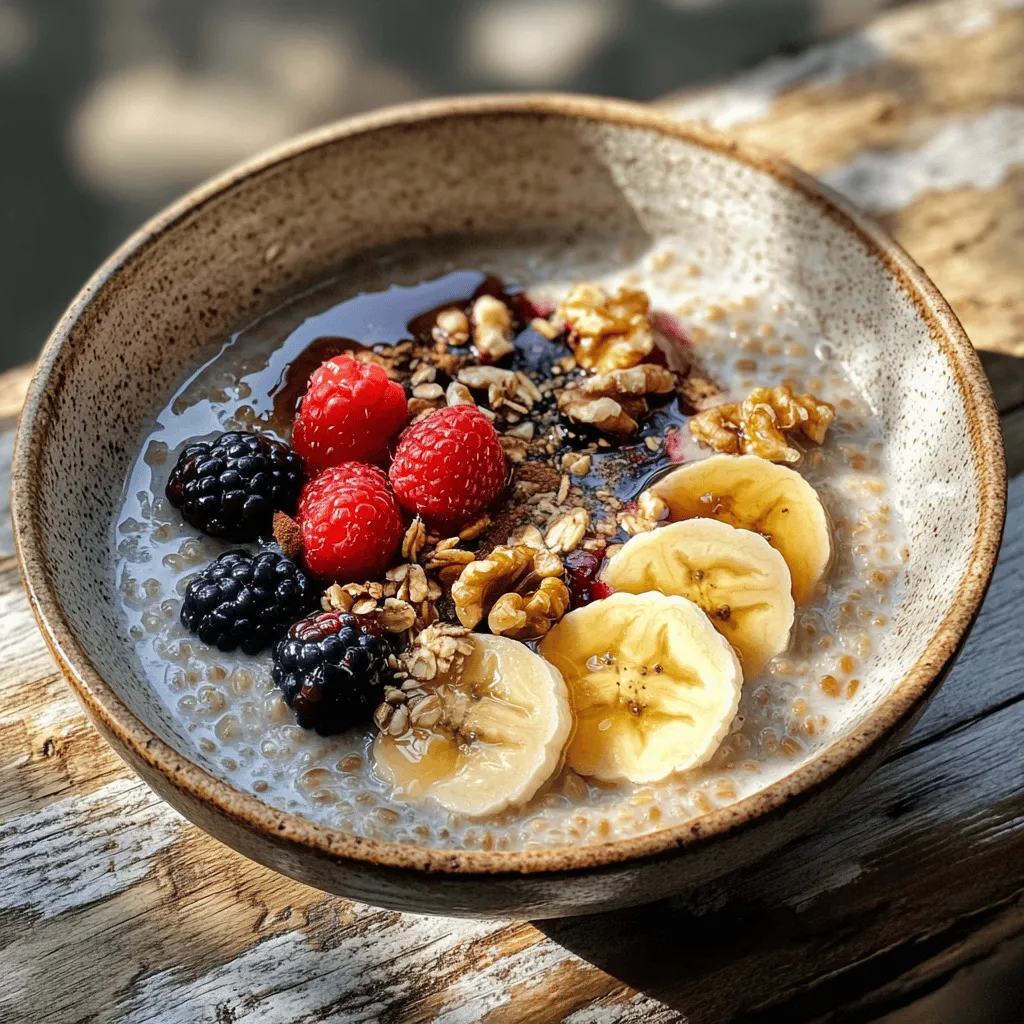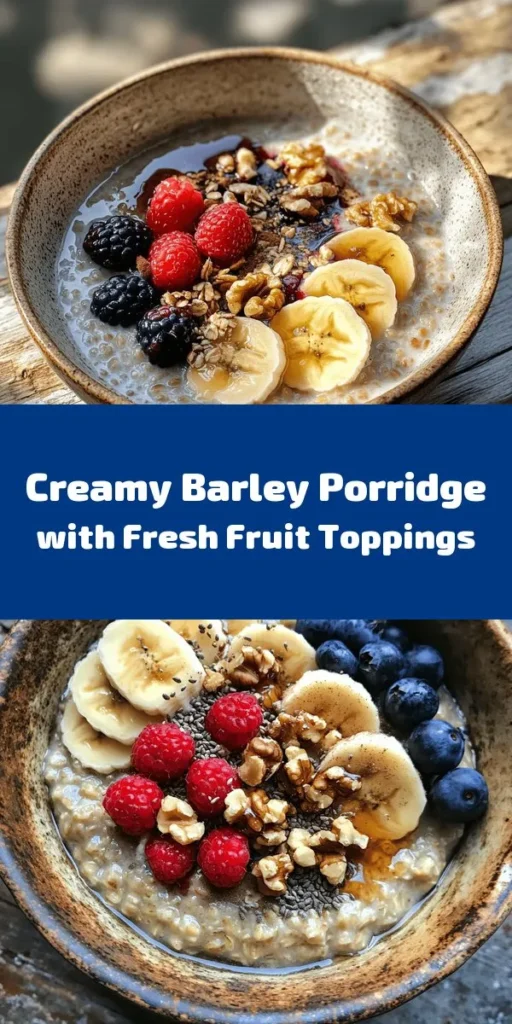Introduction
In the quest for a nutritious breakfast that fuels the body and delights the taste buds, barley porridge stands out as an excellent choice. This ancient grain, often overshadowed by more common cereals like oats and wheat, has been gaining popularity for its impressive health benefits and versatility in the kitchen. Barley porridge is not only a comforting dish but also a powerhouse of nutrients, making it an ideal way to kickstart your day.
As consumer interest shifts towards whole grains, barley has emerged as a star ingredient due to its myriad health benefits. Packed with fiber, vitamins, and minerals, barley porridge offers a wholesome alternative to sugary cereals or processed breakfast options. This recipe is simple to prepare and can be easily customized with various toppings, ensuring it caters to a wide range of tastes and dietary preferences. Whether you are looking for a filling breakfast to sustain you through a busy morning or a warm dish to enjoy on a leisurely weekend, nourishing barley porridge is a delightful option that deserves a place in your breakfast rotation.
Understanding Barley: A Nutritional Powerhouse
Barley is one of the oldest cultivated grains, dating back thousands of years, and its nutritional profile is nothing short of impressive. This whole grain is rich in dietary fiber, particularly beta-glucan, which has been shown to help lower cholesterol levels and improve heart health. In addition to fiber, barley is a good source of essential vitamins and minerals, including B vitamins, iron, magnesium, and selenium. These nutrients play vital roles in energy production, immune function, and overall well-being.
One of the standout features of barley is its high fiber content. A single serving of cooked barley can provide nearly 6 grams of fiber, which is crucial for healthy digestion. This fiber aids in promoting regular bowel movements, preventing constipation, and supporting a healthy gut microbiome. Furthermore, the fiber in barley can help you feel fuller for longer, making it a smart choice for those looking to manage their weight.
By incorporating barley into your diet, you are not only diversifying your grain intake but also taking a proactive approach to your health. Unlike more refined grains, barley retains its bran and germ, which are rich in nutrients and antioxidants. This whole grain is also naturally low in fat and free of cholesterol, making it a heart-healthy choice.
Ingredients Breakdown for Nourishing Barley Porridge
To create the perfect bowl of nourishing barley porridge, it is essential to select high-quality ingredients that contribute to its flavor and health benefits. Here’s a detailed breakdown of each ingredient in the recipe:
– Pearled Barley: The star of this porridge, pearled barley, is a form of barley that has had its outer hull removed. This process gives it a smooth texture and shorter cooking time compared to other forms of barley, such as hulled barley. While pearled barley is less nutritious than its hulled counterpart, it still retains many health benefits, including fiber, protein, and essential minerals. Its chewy texture and nutty flavor make it an excellent base for porridge.
– Water or Vegetable Broth: The choice of liquid is crucial in determining the flavor profile of your barley porridge. Using water will yield a neutral taste, allowing the natural flavors of the barley and toppings to shine through. On the other hand, vegetable broth can enhance the porridge’s taste, adding depth and a hint of savoriness that pairs well with various toppings. Depending on your dietary preferences, both options offer a nutritious foundation for the dish.
– Almond Milk: For those looking to maintain a dairy-free or plant-based diet, almond milk is a fantastic choice. It adds a creamy texture to the porridge while being lower in calories compared to cow’s milk. Almond milk is also rich in vitamin E, an antioxidant that supports skin health and immune function. If you prefer other dairy alternatives, soy milk, oat milk, or coconut milk can also be used, each bringing its unique flavor and health benefits to the porridge.
– Maple Syrup and Natural Sweeteners: To sweeten the porridge, natural sweeteners like maple syrup or honey can be used. These options are preferable to refined sugars, as they provide additional nutrients and flavors. Maple syrup is particularly rich in antioxidants and has a lower glycemic index than regular sugar, making it a healthier choice. Adjust the sweetness to your liking, as the toppings will also contribute to the overall flavor.
– Vanilla Extract and Cinnamon: Adding vanilla extract enhances the flavor of the porridge, giving it a warm and inviting aroma. Vanilla is not only delicious but is also believed to have calming properties. Cinnamon, on the other hand, adds a hint of spice and is known for its anti-inflammatory and antioxidant properties. Together, these ingredients create a comforting and aromatic dish that is perfect for breakfast.
– Salt: While it may seem counterintuitive to add salt to a sweet dish, a pinch of salt is essential for balancing flavors. It enhances the sweetness of the maple syrup and the richness of the almond milk, elevating the overall taste of the porridge. Use a small amount to avoid overpowering the other flavors.
– Toppings: The beauty of barley porridge lies in its versatility, particularly when it comes to toppings. Fresh fruits like bananas, berries, or apples can provide natural sweetness and a burst of flavor. Nuts and seeds, such as almonds, walnuts, or chia seeds, add a satisfying crunch and an extra dose of healthy fats. For a touch of indulgence, consider adding a dollop of nut butter or a sprinkle of granola. Each topping not only enhances the porridge’s flavor but also contributes additional nutrients, making your breakfast even more nourishing.
Step-by-Step Instructions for Perfect Barley Porridge
To prepare nourishing barley porridge, follow these comprehensive steps to ensure a delightful and satisfying breakfast:
1. Rinsing the Barley: Begin by rinsing the pearled barley under cold running water. This step is essential as it helps remove any dust or debris that may have accumulated during packaging. Rinsing also helps to wash away excess starch, which can make the porridge overly thick or gummy. By rinsing the barley, you will achieve a lighter, creamier texture in your final dish.
2. Cooking the Barley: In a medium-sized pot, combine the rinsed barley with water or vegetable broth. The typical ratio is 1 cup of barley to 3 cups of liquid, but this can be adjusted based on your desired consistency. Bring the mixture to a boil over medium-high heat, then reduce the heat to low, cover the pot, and let it simmer gently. Cooking time will vary depending on the type of barley used, but pearled barley usually takes about 25-30 minutes to become tender.
3. Incorporating Almond Milk and Sweeteners: Once the barley is cooked and has absorbed most of the liquid, stir in almond milk to create a creamy consistency. You can adjust the amount of almond milk based on how thick or runny you prefer your porridge. Add a splash of vanilla extract, a sprinkle of cinnamon, and your chosen sweetener. Stir well to combine all the flavors, allowing the porridge to simmer for an additional 5 minutes to meld the ingredients together.
4. Adjusting Consistency and Flavor: After simmering, check the consistency of the porridge. If it seems too thick, you can add more almond milk or water to achieve your desired texture. Taste the porridge and adjust the sweetness or seasoning as necessary. This step is crucial for creating a personalized dish that suits your palate.
With these initial steps, you will create a rich, creamy, and nourishing barley porridge that serves as a hearty foundation for a wholesome breakfast. The versatility of this recipe allows for endless customization, making it a delightful way to embrace the goodness of whole grains. As we continue to explore this nourishing dish, stay tuned for additional topping ideas and tips for perfecting your barley porridge experience.

Cooking Techniques for Perfect Barley Porridge
To achieve the ideal tenderness and consistency in your barley porridge, it’s essential to employ the right cooking techniques. Begin by rinsing the barley under cold water to remove any dust or debris. This simple step can enhance the overall flavor and texture of your porridge.
When cooking barley, the key is to use the correct ratio of water to grains. For a creamy and smooth porridge, use 3 cups of water for every 1 cup of barley. Bring the water to a boil, then reduce the heat to low and cover the pot. Allow the barley to simmer for about 30 to 40 minutes. The longer you cook it, the softer and creamier it will become.
A crucial tip is to keep an eye on the cooking time and water level. If the barley absorbs all the liquid before it’s tender, add a little more water as needed. Stir occasionally to prevent sticking and ensure even cooking. Once the barley is tender and has absorbed most of the water, remove it from the heat and let it sit, covered, for about five minutes. This resting period allows the grains to fluff up and gives you that perfect porridge consistency.
Incorporating Flavorings for a Balanced Taste
A nourishing bowl of barley porridge can be as simple or as complex as you desire, depending on the flavorings you incorporate. Start with the base of your porridge: water or milk (dairy or plant-based). For a richer flavor, consider using almond milk, coconut milk, or even oat milk.
To enhance the natural nuttiness of barley, add a pinch of salt during cooking. This small addition brings out the flavors of the grains. After cooking, consider incorporating spices like cinnamon, nutmeg, or vanilla extract to elevate the taste. A dash of honey or maple syrup can also add sweetness, but adjust it to your preference to maintain a balanced flavor profile.
For a savory twist, consider stirring in herbs such as thyme or rosemary, or even a sprinkle of cheese if you prefer a creamier, more indulgent porridge. The versatility of barley allows you to experiment with various flavors, so don’t hesitate to get creative.
Preparing Toppings: Seasonal and Creative Combinations
Toppings are a fantastic way to add texture and additional flavor to your barley porridge. The choice of toppings can vary with the seasons, providing a fresh experience each time you prepare it.
Fruit Toppings: In the spring and summer, consider topping your porridge with fresh berries such as strawberries, blueberries, or raspberries. In the fall, sliced apples or pears paired with a sprinkle of cinnamon create a delightful autumnal flavor. For winter, try pomegranate seeds or citrus slices for a refreshing contrast.
Nuts and Seeds: Add a handful of nuts—walnuts, almonds, or pecans—for a dose of healthy fats and crunch. Chia seeds or flaxseeds can also be sprinkled on top for added nutrition, enriching the porridge with omega-3 fatty acids.
Yogurt or Nut Butters: A dollop of yogurt can add creaminess, while nut butters like almond or peanut butter provide protein and a satisfying richness. Drizzling a bit of nut butter over your porridge will not only taste great but also add a beautiful visual element.
Sweeteners and Syrups: Finally, drizzle your porridge with honey, maple syrup, or agave nectar for an extra touch of sweetness. You can also experiment with flavored syrups, such as vanilla or caramel, to enhance the dish.
Serving Suggestions for Presentation and Pairing
Presentation plays a significant role in enjoying your nourishing barley porridge. Serve it in a deep bowl, allowing the toppings to create an appealing visual contrast against the creamy base. Layer the toppings in an artistic fashion, showcasing vibrant fruits and crunchy nuts to entice the eyes before the taste buds.
For beverages that complement your barley porridge, consider serving it with fresh fruit juices, herbal teas, or even a warm cup of coffee. The choice of beverage can enhance your breakfast experience, offering a refreshing or comforting counterpart to the hearty porridge.
Health Benefits of Barley Porridge
Barley porridge is not only delicious but also packed with health benefits that make it an excellent breakfast choice. One of the standout features of barley is its high fiber content. Fiber plays a crucial role in promoting satiety, keeping you fuller for longer, which can help prevent overeating throughout the day. This is particularly beneficial for those looking to manage their weight or improve their digestive health.
Additionally, barley is rich in beta-glucans, a type of soluble fiber that has been shown to lower cholesterol levels and support heart health. The antioxidants found in barley, along with those in nuts and fruits, combat oxidative stress in the body, contributing to overall health and wellness.
Starting your day with a balanced breakfast, such as barley porridge, can significantly influence your energy levels and mood. The slow-releasing carbohydrates found in barley provide sustained energy, helping to maintain stable blood sugar levels throughout the morning.
Customization: Making Barley Porridge Your Own
One of the most appealing aspects of barley porridge is its versatility. You can easily customize your porridge to suit your taste preferences, dietary restrictions, or seasonal availability of ingredients.
Alternative Grains: If you’re looking to switch things up, consider using other whole grains like quinoa, farro, or steel-cut oats. Each grain offers unique flavors and textures while still providing nutritional benefits.
Seasonal Fruits and Toppings: As mentioned earlier, the toppings can change with the seasons. Embrace the seasonal produce available to you, allowing your porridge to evolve throughout the year. Fresh peaches in the summer, roasted nuts in the fall, or citrus fruits in the winter can all enhance your breakfast experience.
Dietary Modifications: For those with dietary restrictions, barley porridge can be adjusted to meet specific needs. If you’re looking for gluten-free options, substitute barley with gluten-free grains like quinoa or millet. For a vegan approach, simply use plant-based milk alternatives and avoid honey, opting for agave syrup or maple syrup instead.
Sustainability and Barley as a Grain Choice
In an age where sustainability is a growing concern, choosing barley as a grain can be an eco-conscious decision. Barley is known for its resilience and adaptability, making it a more sustainable crop compared to other grains. It requires less water and is less susceptible to pests, which reduces the need for chemical pesticides.
Choosing locally sourced barley not only supports local farmers but also reduces your carbon footprint by minimizing transportation emissions. By incorporating barley porridge into your diet, you’re making a choice that aligns with a more sustainable lifestyle, promoting both personal health and environmental well-being.
Conclusion
Nourishing barley porridge stands out as a wholesome, easy-to-prepare breakfast option that is rich in nutrients and customizable to fit your preferences. With its high fiber content, barley supports digestive health and provides lasting energy, making it an ideal choice for starting your day right.
The versatility of barley porridge allows you to explore a variety of flavors and toppings, ensuring that each bowl can be a unique experience. From seasonal fruits to creative nut toppings, you can personalize your porridge to match your mood and the season.
Incorporating whole grains like barley into your daily diet is a simple yet effective way to enhance your overall health and well-being. Whether you’re looking for a quick breakfast solution or a hearty meal to fuel your day, barley porridge is a satisfying choice that celebrates the nourishing power of whole grains. Embrace this recipe and make it a staple in your breakfast rotation, enjoying the simple yet fulfilling nature of a warm bowl of barley porridge.



